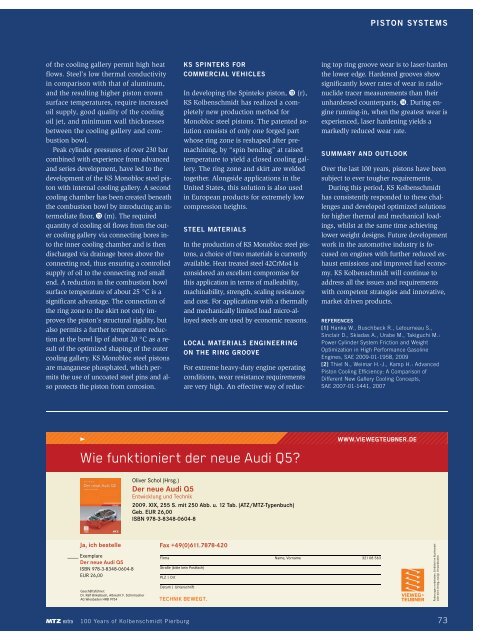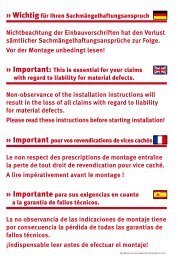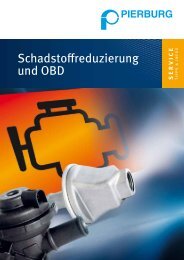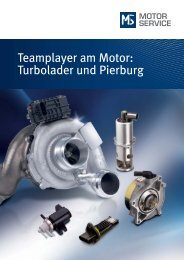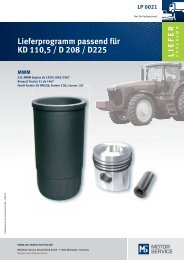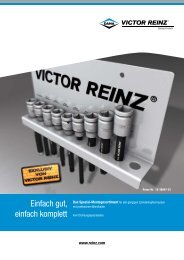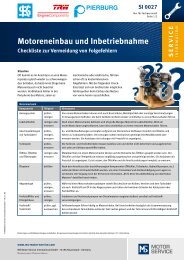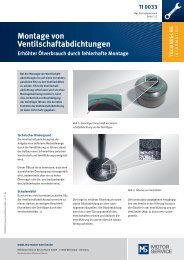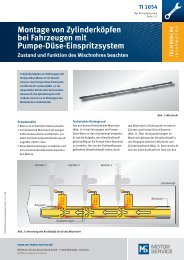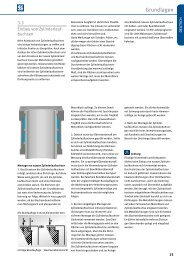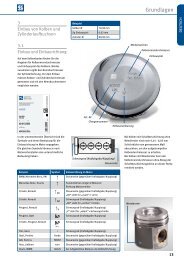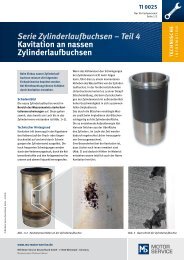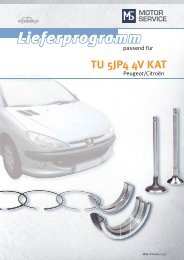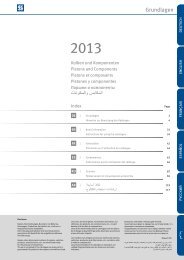Die Sonderausgabe der MTZ hier herunterladen (6 MB - MS Motor ...
Die Sonderausgabe der MTZ hier herunterladen (6 MB - MS Motor ...
Die Sonderausgabe der MTZ hier herunterladen (6 MB - MS Motor ...
Erfolgreiche ePaper selbst erstellen
Machen Sie aus Ihren PDF Publikationen ein blätterbares Flipbook mit unserer einzigartigen Google optimierten e-Paper Software.
of the cooling gallery permit high heat<br />
flows. Steel’s low thermal conductivity<br />
in comparison with that of aluminum,<br />
and the resulting higher piston crown<br />
surface temperatures, require increased<br />
oil supply, good quality of the cooling<br />
oil jet, and minimum wall thicknesses<br />
between the cooling gallery and combustion<br />
bowl.<br />
Peak cylin<strong>der</strong> pressures of over 230 bar<br />
combined with experience from advanced<br />
and series development, have led to the<br />
development of the KS Monobloc steel piston<br />
with internal cooling gallery. A second<br />
cooling chamber has been created beneath<br />
the combustion bowl by introducing an intermediate<br />
floor, � (m). The required<br />
quantity of cooling oil flows from the outer<br />
cooling gallery via connecting bores into<br />
the inner cooling chamber and is then<br />
discharg ed via drainage bores above the<br />
connecting rod, thus ensuring a controlled<br />
supply of oil to the connecting rod small<br />
end. A reduction in the combustion bowl<br />
surface temperature of about 25 °C is a<br />
significant advantage. The connection of<br />
the ring zone to the skirt not only improves<br />
the piston’s structural rigidity, but<br />
also permits a further temperature reduction<br />
at the bowl lip of about 20 °C as a result<br />
of the optimized shaping of the outer<br />
cooling gallery. KS Monobloc steel pistons<br />
are manganese phosphated, which permits<br />
the use of uncoated steel pins and also<br />
protects the piston from corrosion.<br />
KS SPINTEKS FOR<br />
COMMERCIAL VEHICLES<br />
In developing the Spinteks piston, � (r),<br />
KS Kolbenschmidt has realized a completely<br />
new production method for<br />
Monobloc steel pistons. The patented solution<br />
consists of only one forged part<br />
whose ring zone is reshaped after premachining,<br />
by “spin bending” at raised<br />
temperature to yield a closed cooling gallery.<br />
The ring zone and skirt are welded<br />
together. Alongside applications in the<br />
United States, this solution is also used<br />
in European products for extremely low<br />
compression heights.<br />
STEEL MATERIALS<br />
In the production of KS Monobloc steel pistons,<br />
a choice of two materials is currently<br />
available. Heat treated steel 42CrMo4 is<br />
consi<strong>der</strong>ed an excellent compromise for<br />
this application in terms of malleability,<br />
machinability, strength, scaling resistance<br />
and cost. For applications with a thermally<br />
and mechanically limited load micro-alloyed<br />
steels are used by economic reasons.<br />
LOCAL MATERIALS ENGINEERING<br />
ON THE RING GROOVE<br />
For extreme heavy-duty engine operating<br />
conditions, wear resistance requirements<br />
are very high. An effective way of reduc-<br />
����������������������������������<br />
��������������������<br />
����������������<br />
�����������������������<br />
��������������������������������������������������������������<br />
��������������� ���������������������������������<br />
����������������<br />
���������������<br />
����������������<br />
������������������������<br />
���������<br />
�����������������<br />
���������������������������������������������<br />
���������������������<br />
����������������������<br />
100 Years of Kolbenschmidt Pierburg<br />
����������������������<br />
ing top ring groove wear is to laser-harden<br />
the lower edge. Hardened grooves show<br />
significantly lower rates of wear in radionuclide<br />
tracer measurements than their<br />
unhardened counterparts, �. During engine<br />
running-in, when the greatest wear is<br />
experienced, laser hardening yields a<br />
markedly reduced wear rate.<br />
SUMMARY AND OUTLOOK<br />
PISTON SYSTE<strong>MS</strong><br />
Over the last 100 years, pistons have been<br />
subject to ever tougher requirements.<br />
During this period, KS Kolbenschmidt<br />
has consistently responded to these challenges<br />
and developed optimized solutions<br />
for higher thermal and mechanical loadings,<br />
whilst at the same time achieving<br />
lower weight designs. Future development<br />
work in the automotive industry is focused<br />
on engines with further reduced exhaust<br />
emissions and improved fuel economy.<br />
KS Kolbenschmidt will continue to<br />
address all the issues and requirements<br />
with competent strategies and innovative,<br />
market driven products.<br />
REFERENCES<br />
[1] Hanke W., Buschbeck R., Letourneau S.,<br />
Sinclair D., Skiadas A., Urabe M., Takiguchi M.:<br />
Power Cylin<strong>der</strong> System Friction and Weight<br />
Optimization in High Performance Gasoline<br />
Engines, SAE 2009-01-1958, 2009<br />
[2] Thiel N., Weimar H.-J., Kamp H.: Advanced<br />
Piston Cooling Efficiency: A Comparison of<br />
Different New Gallery Cooling Concepts,<br />
SAE 2007-01-1441, 2007<br />
��������������������<br />
��������������������<br />
������� ��������������<br />
����������<br />
�����������������������������<br />
���������<br />
��������������������<br />
��������������� ������������������������������������������������<br />
���������������������������������������<br />
73


